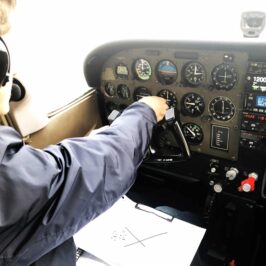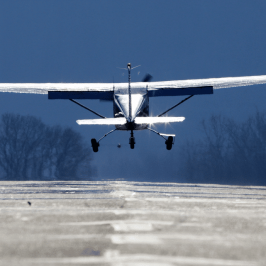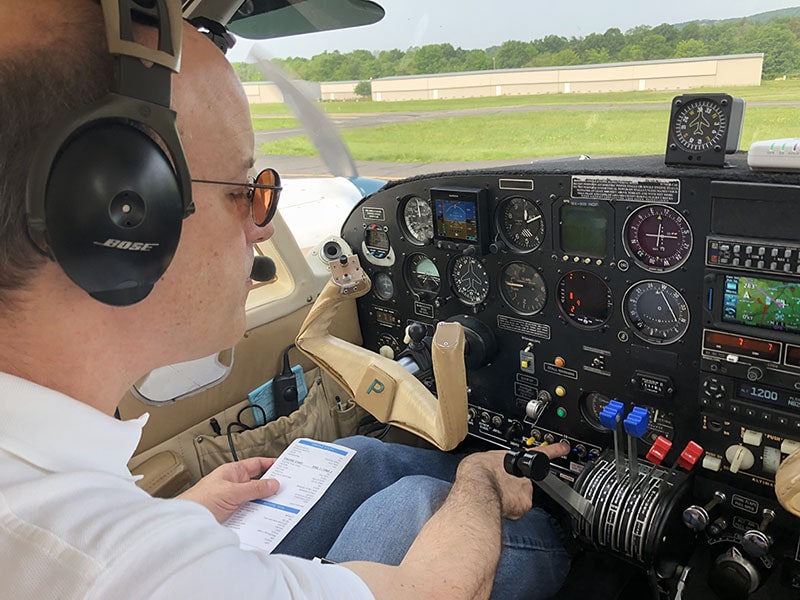
The flight deck of a light piston multiengine airplane is a busy place for a single pilot. Lots to do, and a short amount of time to do it; lots of redundancy, but lots of skill needed to take true advantage of it.
Depending on the phase of flight, that can be an exaggeration or an understatement. On a nice weather day in cruise, there aren’t too many problems — short of an on-board fire — which would expose a critical weakness in the light twin’s redundancy. But on takeoff, regardless of the weather, the pilot’s attention needs to be focused purely on the task at hand. A quick, but sure and smooth reaction is required in the event of a low-speed, low altitude engine failure. The proper reaction is driven by the proper takeoff briefing.
Something I’ve noticed in my observation of briefs in the light twin is a tendency to translate elements of the single-engine takeoff briefing to the light twin. For example, discussion of whether the landing gear is in the retracted or extended position; and whether there is runway remaining — as part of the brief.
But for the most part, and in most “common” emergency scenarios, we should really only care about one thing when deciding to abort or continue: airspeed.

In the image above, we note the two radial lines presented on the face of the airspeed indicator which indcate VMCA (red) and VYSE (blue). VYSE is typically called “blue line” when calling out airspeeds.
Let’s review the meaning of these terms. (Click to expand.)
§ 23.149 Minimum control speed.
(a) VMC is the calibrated airspeed at which, when the critical engine is suddenly made inoperative, it is possible to maintain control of the airplane with that engine still inoperative, and thereafter maintain straight flight at the same speed with an angle of bank of not more than 5 degrees. The method used to simulate critical engine failure must represent the most critical mode of powerplant failure expected in service with respect to controllability.
VYSE (best rate of climb, single engine)
VYSE—best rate of climb speed with OEI (One Engine Inoperative). Marked with a blue radial line on most airspeed indicators. (from the Airplane Flying Handbook, Chapter 12.)
VMCA (air) is differentiated from VMCG (ground) as some manufacturers publish a Minimum Controllable Speed on the ground for certain multiengine airplanes.
In the simplest possible terms, these speeds divide the takeoff into three segments. Assuming a properly loaded aircraft, up to VMCA , abort; at or above VYSE , we may consider continuing.
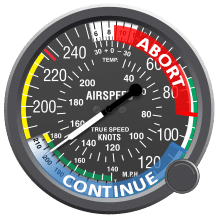
In this example, VMCA is 90 MPH IAS (78 KIAS) and VYSE is 105 MPH IAS (91 KIAS.)
Below VMCA
Thinking about the brief, when it comes to abort criteria, what role does the position of the landing gear play?
We know that VMCA is the “minimum controllable speed.” Therefore we know that below this speed, the aircraft will not be controllable with one engine inoperative, so the only solution is to pull the throttle of the operative engine to idle and land — regardless of whether the landing gear is extended or retracted.
The answer to the previously presented question, then, is that “it doesn’t matter” when it comes to the gear. So any brief related to its position is a moot point for this phase of the takeoff, from a practical perspective.
What about whether there is “runway remaining” for landing? Again, we know the aircraft is simply not controllable with one engine inoperative below VMCA . Therefore the availability of runway or lack thereof makes no difference – the outcome will be the same. The pilot must retard the operative engine’s throttle to idle and land, even if obstacles are present.
We’ve established that “Below VMCA ” there is no decision-making to be made, only pilot action. And it is always the same action.
Above VYSE
We’ve also broached the subject of continuing the takeoff at or above VYSE . The stated action is to consider continuing the takeoff. There’s a fair amount of detail here to wade through, but let’s stick to the basics, first and foremost: all “considerations” are to be taken into account prior to the takeoff. The considerations form the plan, and the pilot should brief the plan. If the calculated performance allows for a safe climbout, here is where the pilot briefs the plan to continue the takeoff, at or above VYSE .
Again, what role does the position of the landing gear or “runway remaining” play here? Almost none – unless it’s a very long runway. Ideally, by the time the aircraft has reached VYSE the landing gear will have already been retracted. Considering that the landing gear in the extended position contributes to a significant amount of drag, leaving it exposed to the slipstream will primarily do only one thing: increase the length of time it takes for the aircraft to accelerate to VYSE . And that’s Not a Good Thing.
So we have two out of three accounted for. That leaves “No Man’s Land.”
Below VMCA
< 90 MPH
Abort – regardless of any circumstances.
“No Man’s Land”
> 90 MPH < 105 MPH
?
At or above VYSE
> 105 MPH
Continue – if performance allows for a safe climbout.
No Man’s Land
This nebulous airspeed range found between VMCA and VYSE requires consideration for every takeoff. There are a myriad of possibilities here to think through.
If the pilot finds him or herself dealing with an engine failure in this small slice of time and narrow airspeed band, what should be done?
The first consideration is controllability. Is the aircraft controllable? Above VMCA , it should be. But what about the ability to climb? Below VYSE , this may not be possible. The aircraft may need to accelerate to or near VYSE before a climb can be effected.
This means the length of the runway, the density altitude, the weight of the aircraft, and the presence of obstacles on the climbout should all be considered.
Scenario: “long” runway (8,000 ft. +), sea level, 15 degrees C, no wind, aircraft 10% below maximum gross takeoff weight, no terrain or obstructions to be concerned about on the climbout. Go or no go with an engine failure squarely at 97 MPH IAS? At the very least, there are two possible outcomes here.
- The pilot could abort and land on the remaining runway, assuming a typical takeoff roll of 1000 to 1500 feet for a lightly loaded light twin (these are very generic numbers, skewed to the conservative side – check your AFM.) In the worse case, this might involve a low airspeed excursion off the departure end of the runway, but chances for survival are excellent.
- The pilot could continue the takeoff by accelerating to VYSE and climbing out at VYSE .
During the takeoff briefing, it’s time for the pilot to determine where to “slide” his abort/continue airspeed on the airspeed indicator. It’s a judgement call, but here’s mine. For the conditions described, I would opt to abort below blue line ( VYSE ) and continue above that speed. That makes for a very easy takeoff briefing. In essence, we could sum up the briefing with this image:

Note that we’ve “filled in” the “No Man’s Land” area of the ASI (circled above) with a decisive choice. In this case, we’ll abort. With that decision made, we’ll initiate the takeoff roll with a plan in mind and no “decisions” to make, just actions to take. That’s a Good Thing.
What change in conditions could effect a change in how we brief?
Let’s modify the scenario slightly to a shorter runway: 3000 feet, but everything else remains the same. Now it’s time to take a look at performance. Specifically, Accelerate-Stop Distance. Let’s look at what we come up with for our scenario aircraft.
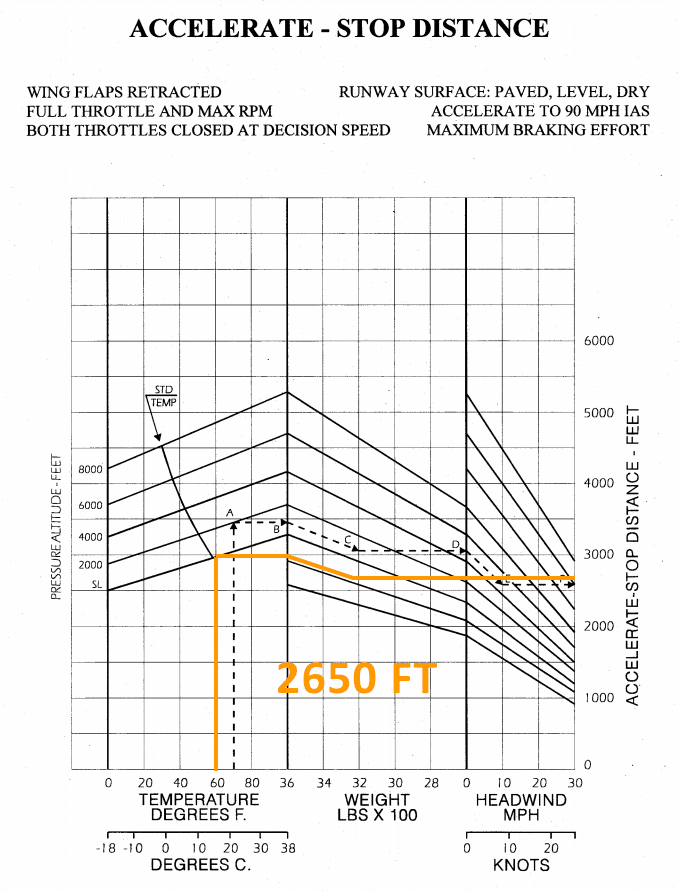
Now, the calculus is more involved because the length of the runway is only slightly greater than the calculated Accelerate-Stop Distance. Given that we’re questioning whether to continue once airborne above VMCA , but below VYSE , it’s easy to surmise that any decision to abort above 90 MPH IAS will result in an off-runway excursion. After all, the chart above assumes a ground abort at 90 MPH IAS, not an in-flight abort at some higher airspeed. The difference between pulling the throttles and executing a maximum braking effort at 90 MPH IAS on the ground vs. in the air is a significant one. Without getting into a lot of math, the pilot is assured that the distance required to stop will exceed the available runway in this scenario.
Again, it’s a judgement call; and again, here is mine.

Given the weight of the aircraft, low density altitude, and short runway, I’ll choose to bet on the performance of the aircraft being acceptable to accelerate to VYSE and then climb out.
Many factors could apply here. Familiarity with the aircraft, for one. Recency of multiengine training to include OEI work. And many more. It’s very possible another pilot might elect to abort in “No Man’s Land.”
But the point here is to have a plan for what will happen at all phases of the takeoff.
My suggestion is to eliminate the consideration of the landing gear from the brief. It has little to no bearing on the decisions being made on the flight deck, and is a complication to the decision-making process. The pilot should select airspeeds which “bookend” the various phases of the takeoff and have plan for each one of those segments.
Safe Flights!
-Ryan

